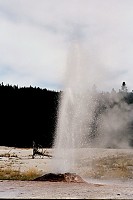 Pink
Cone Geyser. Pink Cone, like all the stuff in this particular gallery,
is located along the Firehole Lake Drive in the Lower Geyser Basin.
That makes it good for people who cannot or will not get far from their
cars. In fact the road is so close to the geyser, when they built
the road they cut into the broad geyserite mound pink cone sits on and
sliced into some minor parts of it's plumbing system, which hiss and spit
a tiny bit while it is in eruption. Pink cone erupts about
30 feet high, long eruptions that last two hours or so about every
16 hours. In the early days of the park it was a rare performer,
but the big Hegben Lake earthquake in 1959 caused it to start erupting
much more frequently.
Pink
Cone Geyser. Pink Cone, like all the stuff in this particular gallery,
is located along the Firehole Lake Drive in the Lower Geyser Basin.
That makes it good for people who cannot or will not get far from their
cars. In fact the road is so close to the geyser, when they built
the road they cut into the broad geyserite mound pink cone sits on and
sliced into some minor parts of it's plumbing system, which hiss and spit
a tiny bit while it is in eruption. Pink cone erupts about
30 feet high, long eruptions that last two hours or so about every
16 hours. In the early days of the park it was a rare performer,
but the big Hegben Lake earthquake in 1959 caused it to start erupting
much more frequently.
Like most features in the Lower geyser basin Pink Cone sits in a cluster
of other thermal features (named in this case the "Pink Cone Group" oddly
enough). These groups are fairly widely separated from each other. Several
of it's immediate neighbors have the same dark pink color to their deposits
caused by traces of manganeese minerals in the geyserite. It looks
a bit dark in this shot, partly because it is wet, and partly because I
played with the image a bit to bring out the shape of the water column,
which was hard to see against the overcast sky. I have a much uglier
spooky backlit shot of Pink Cone here.
 Box
Spring, also in the Pink Cone Group. I'm pretty certain it is Box
Spring. I could be wrong as it is hard to see where the various springs
of the Pink Cone Group are if they are not erupting (all except one are
geysers), and compare their locations to the map in my geyser book.
It is illegal and very dangerous (read Death in Yellowstone), and
very damaging to the mineral formations (geyserite is crushed to powder
by hiking boots) to wander off the trails in the thermal areas in Yellowstone.
Box
Spring, also in the Pink Cone Group. I'm pretty certain it is Box
Spring. I could be wrong as it is hard to see where the various springs
of the Pink Cone Group are if they are not erupting (all except one are
geysers), and compare their locations to the map in my geyser book.
It is illegal and very dangerous (read Death in Yellowstone), and
very damaging to the mineral formations (geyserite is crushed to powder
by hiking boots) to wander off the trails in the thermal areas in Yellowstone.
Actually, I was waiting for Bead Geyser, which is taller and closer
to the road and happens to be one of the most regular of Yellowstone's
geysers, when I noticed Box Spring erupting. Box Spring is kind of irregular
and infrequent, so although it was a good way back from the road and only
maybe 5 feet high, it was something I had never seen before, and I was
happy. As far as I know it was not active before the big 1959 earthquake.
Many of the geysers in the Pink Cone Group became more active then.
I never did see Bead erupt that day.
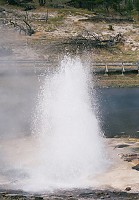 We
continued down the road a bit to the Black Warrior Group where we saw Artesia
Geyser. OK, this is another one where I am not quite 100% certain
of the name. There are three geysers close together here, and their
names got scrambled around a bit over the years. To make matters
worse, there were steam explosions in 1975 which changed the other two
(Gray Bulger and Young Hopeful) from a bunch of separate vents to two larger
connected craters. Whichever it is, this guy was erupting maybe six
to 12 feet tall every minute or so for maybe 20 or 30 seconds.
We
continued down the road a bit to the Black Warrior Group where we saw Artesia
Geyser. OK, this is another one where I am not quite 100% certain
of the name. There are three geysers close together here, and their
names got scrambled around a bit over the years. To make matters
worse, there were steam explosions in 1975 which changed the other two
(Gray Bulger and Young Hopeful) from a bunch of separate vents to two larger
connected craters. Whichever it is, this guy was erupting maybe six
to 12 feet tall every minute or so for maybe 20 or 30 seconds.
The Black Warrior Group takes it's name from nearby Steady Geyser, which
is also known as Black Warrior Geyser. More name confusion.
Steady is a large perpetual spouter, it never stops erupting, so technically
it is not really a geyser. Geysers have to rest from time to time.
Geysers are powered by underground steam explosions and are much less common
than perpetual spouters, which can just be from plain old water pressure,
and might not even be particularly hot. There is a very large hot
spring here called Firehole Lake (you can see it behind Artesia) with a
boardwalk around it, and an even bigger hot pool called Hot Lake which
evidently is sort of a catch basin for the water from the springs and geysers
in the area. There is (was) also a short nature trail called the
Three Senses Trail that is (was) kind of neat. It was basically designed
for blind people. You followed a rope with wooden stops on it in
front of signs that had a regular version for sighted people, and a braille
version that pointed out things to feel and smell and listen to.
Unfortunately the Park Service is not maintaining it anymore because of
lack of money to keep replacing the signs that evil people keep destroying.
I used to like to close my eyes and walk it, but it was too sad to see
it all torn up this time.
 The
above mentioned Young Hopeful and Gray Bulger Geysers. As best as
I can tell that is Gray Bulger bubbling up a few feet. If so, Young
Hopeful is the quiet part to the left. Like Artesia it was also erupting every
minute or two.
The
above mentioned Young Hopeful and Gray Bulger Geysers. As best as
I can tell that is Gray Bulger bubbling up a few feet. If so, Young
Hopeful is the quiet part to the left. Like Artesia it was also erupting every
minute or two.
 After
the Black Warrior Group we went to see the Fountain Paint Pot area at the
end of the one way Firehole Lake Drive. I took no pictures there,
it was fairly quiet. Now, the original plan for the day had been
to go on a half day hike elsewhere in the Lower Basin, but on the drive
over we stopped at the Old Faithful Visitor's Center and I noticed that
Great Fountain Geyser, which is near the beginning of the Firehole Lake
Drive, was scheduled to erupt in the early afternoon. That, and we were
delayed because mom and Jennifer had to hit some gift shops. That
is why we stopped along the Firehole Lake Drive, hoping Great Fountain would erupt
early in the three hour window of it's prediction. I don't think
anyone was really eager for a long hike, I wasn't with the massive blister
on my foot, so we decided to circle around the drive again and wait on
Great Fountain. This little sedum looking plant was growing near
the parking area for Great Fountain.
After
the Black Warrior Group we went to see the Fountain Paint Pot area at the
end of the one way Firehole Lake Drive. I took no pictures there,
it was fairly quiet. Now, the original plan for the day had been
to go on a half day hike elsewhere in the Lower Basin, but on the drive
over we stopped at the Old Faithful Visitor's Center and I noticed that
Great Fountain Geyser, which is near the beginning of the Firehole Lake
Drive, was scheduled to erupt in the early afternoon. That, and we were
delayed because mom and Jennifer had to hit some gift shops. That
is why we stopped along the Firehole Lake Drive, hoping Great Fountain would erupt
early in the three hour window of it's prediction. I don't think
anyone was really eager for a long hike, I wasn't with the massive blister
on my foot, so we decided to circle around the drive again and wait on
Great Fountain. This little sedum looking plant was growing near
the parking area for Great Fountain.
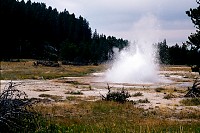 Just
a few dozen yards before the parking area at Great Fountain Geyser
and on the side of the road opposite the geyser itself is a thermal area
right next to the road with a small creek running through it. The
creek is White Creek. Botryoidal Spring, pictured here in eruption,
is one of the many small geysers in this area. Actually, it is taller
than me, so I don't think of it as all that small. It is maybe 15
or 20 feet tall. It erupts every few minutes for a few seconds,
which makes it a fine geyser in my book, fairly big and easy to catch.
It gets its name from a latin word for grape. Evidently the formations
around it's crater are kind of grapelike, but I couldn't see that because
there is no trail through this little thermal area for a close view.
Just
a few dozen yards before the parking area at Great Fountain Geyser
and on the side of the road opposite the geyser itself is a thermal area
right next to the road with a small creek running through it. The
creek is White Creek. Botryoidal Spring, pictured here in eruption,
is one of the many small geysers in this area. Actually, it is taller
than me, so I don't think of it as all that small. It is maybe 15
or 20 feet tall. It erupts every few minutes for a few seconds,
which makes it a fine geyser in my book, fairly big and easy to catch.
It gets its name from a latin word for grape. Evidently the formations
around it's crater are kind of grapelike, but I couldn't see that because
there is no trail through this little thermal area for a close view.
This area also has several other smaller geysers easily visible from
the road, and is well worth checking out, especially if you are waiting
for a predicted eruption of Great Fountain like I was. Also, on the
other side of the road a little farther up from the parking area are two
interesting hot springs. Surprise Spring does not erupt, but does
intermittently ebb and overflow, which would technically make it a geyser
with an eruption height of 0 by some definitions. Firehole Pool is
either a small geyser or perpetual spouter (it has short pauses in it's
splashing, so it's a judgment call) but the really interesting thing is
that you can see jets of steam enter the pool and quickly collapse.
They do look like little tongues of blue flame sort of, which is how the
spring got it's name. Too bad the camera wasn't able to catch those.
Maybe with a polarizing filter?
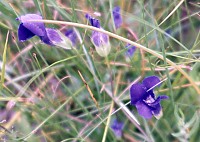 I
knew that Great Fountain had at least say 60 to 90 minutes before it's
eruption because it overflows that long before it erupts, and it wasn't overflowing, so I decided
to walk up White Creek a while. There is a trail, probably not "official"
anymore (although it must have been at one time, there are faded orange
trail markers of some of the trees), and not maintained, along the base of
the hill by White Creek. It is difficult to find the start of the trail in the
trees at the Great Fountain parking area, unless you find an old trail
marker, but after a few yards the path along the base of the hill is obvious
and pretty easy to follow. You can see where the trail is if you
are standing an the road near White Creek and look along the base of the
hill to the left of the creek. There is a section or two where the
trail cuts across small creeks or ravines coming down from the hill and
is kind of swampy (I detoured up the ravine as I was wearing sandals) or
gets hard to follow through a few meadows filled with wildflowers like
this one. I believe this is some kind of Gentian. The Fringed
Gentian is Yellowstone's official park flower, but this one isn't quite
as fringed as I remembered them being, so maybe a different species?
There are a few small geysers scattered along the creek, and some very
pretty pools. It was in one of these pools that scientists discovered
the bacteria Thermus
aquaticus that produces the enzyme Taq polymerase, that is used
in nifty things like PCR machines that allow molecular biologists to work
with amazingly tiny amounts of DNA.
I
knew that Great Fountain had at least say 60 to 90 minutes before it's
eruption because it overflows that long before it erupts, and it wasn't overflowing, so I decided
to walk up White Creek a while. There is a trail, probably not "official"
anymore (although it must have been at one time, there are faded orange
trail markers of some of the trees), and not maintained, along the base of
the hill by White Creek. It is difficult to find the start of the trail in the
trees at the Great Fountain parking area, unless you find an old trail
marker, but after a few yards the path along the base of the hill is obvious
and pretty easy to follow. You can see where the trail is if you
are standing an the road near White Creek and look along the base of the
hill to the left of the creek. There is a section or two where the
trail cuts across small creeks or ravines coming down from the hill and
is kind of swampy (I detoured up the ravine as I was wearing sandals) or
gets hard to follow through a few meadows filled with wildflowers like
this one. I believe this is some kind of Gentian. The Fringed
Gentian is Yellowstone's official park flower, but this one isn't quite
as fringed as I remembered them being, so maybe a different species?
There are a few small geysers scattered along the creek, and some very
pretty pools. It was in one of these pools that scientists discovered
the bacteria Thermus
aquaticus that produces the enzyme Taq polymerase, that is used
in nifty things like PCR machines that allow molecular biologists to work
with amazingly tiny amounts of DNA.
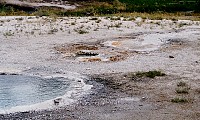 This
is Tuft Geyser. Tuft is the light tan crescent shaped formation to
the back and the right. Believe it or not, it is in full eruption.
OK, if this was a movie you could see the water droplets moving, and you
would believe me. I did say there were some small geysers
farther up White Creek. When I got there the runoff channel leading
back and to the right was dry and empty. I decided to rest a while
and soon the vents began to slowly ooze water and gradually steam began
to spray droplets a few inches high. After a few minutes it was in
full eruption, some of the droplets reaching a foot or two high.
Tuft's intervals are 50 to 100 minutes and the eruptions last 5 to 30 minutes.
I watched it a while and left to see other things. When I got back
half an hour later it was quiet again.
This
is Tuft Geyser. Tuft is the light tan crescent shaped formation to
the back and the right. Believe it or not, it is in full eruption.
OK, if this was a movie you could see the water droplets moving, and you
would believe me. I did say there were some small geysers
farther up White Creek. When I got there the runoff channel leading
back and to the right was dry and empty. I decided to rest a while
and soon the vents began to slowly ooze water and gradually steam began
to spray droplets a few inches high. After a few minutes it was in
full eruption, some of the droplets reaching a foot or two high.
Tuft's intervals are 50 to 100 minutes and the eruptions last 5 to 30 minutes.
I watched it a while and left to see other things. When I got back
half an hour later it was quiet again.
The hole between tuft and the pool at the lower left is Eclipse Geyser.
It is only rarely active, jets water about eight feet high, but when it
is active it eclipses Tuft, making it completely dormant. It wasn't
until the 1970's that anyone realized these features were geysers.
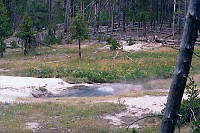 A
bit farther up White Creek is Spindle Geyser. Again, not very tall,
I doubt that it was much more than one foot this day (it can do a little
better) but interesting to watch. After an eruption the pool drains
down a good bit below overflow, then starts to refill. Once it starts
overflowing heavily it begins it's bursting, splashing eruption that lasts
a few seconds, then starts the process over again. The whole cycle
takes only a few minutes.
A
bit farther up White Creek is Spindle Geyser. Again, not very tall,
I doubt that it was much more than one foot this day (it can do a little
better) but interesting to watch. After an eruption the pool drains
down a good bit below overflow, then starts to refill. Once it starts
overflowing heavily it begins it's bursting, splashing eruption that lasts
a few seconds, then starts the process over again. The whole cycle
takes only a few minutes.
 This
is Buffalo Pool. It got it's name because several bison have fallen
into it and left their bones in it. Like many of Yellowstone's hot
springs it has fairly wide shelves of fragile sinter around it's edges
that look like solid ground but aren't. Sometimes a hot pool can
even be completely covered over, and can even have grass growing on the
fragile crust. Kind of like nature's boiling water land mines I guess.
Today it was a tree rather than a bison that had fallen in. The needles
were brown, but still on the tree, so it must have fallen in fairly recently.
It had been in long enough that the parts that were in the water were turning
white from siliceous sinter being deposited in and on them. If this
goes on long enough then those parts will become petrified, maybe to be
studied by some far future paleontologist.
Maybe some day the entire trunk will become petrified and form a long narrow
bridge across the pool - nah, probably some tourist will climb across it
and break it and fall to a horrible death.
This
is Buffalo Pool. It got it's name because several bison have fallen
into it and left their bones in it. Like many of Yellowstone's hot
springs it has fairly wide shelves of fragile sinter around it's edges
that look like solid ground but aren't. Sometimes a hot pool can
even be completely covered over, and can even have grass growing on the
fragile crust. Kind of like nature's boiling water land mines I guess.
Today it was a tree rather than a bison that had fallen in. The needles
were brown, but still on the tree, so it must have fallen in fairly recently.
It had been in long enough that the parts that were in the water were turning
white from siliceous sinter being deposited in and on them. If this
goes on long enough then those parts will become petrified, maybe to be
studied by some far future paleontologist.
Maybe some day the entire trunk will become petrified and form a long narrow
bridge across the pool - nah, probably some tourist will climb across it
and break it and fall to a horrible death.
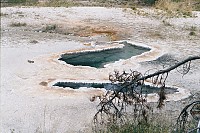 Some
hot spring next to Buffalo Pool. I thought it was kind of pretty.
Some
hot spring next to Buffalo Pool. I thought it was kind of pretty.
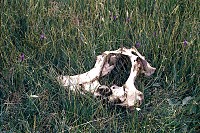 I
found this pelvis from some big animal in a meadow along the creek.
I
found this pelvis from some big animal in a meadow along the creek.
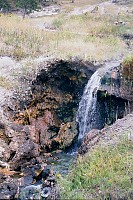 This
is as far as I got up White Creek that day, or on any of my previous trips.
It was getting late and I needed to head back to see if Great Fountain
was showing any signs of erupting soon. White Creek is pretty hot
water, like very hot bath water, and I have always been curious to see
what it is upstream that puts out that much hot water. Maybe next
trip to Yellowstone I will find out.
This
is as far as I got up White Creek that day, or on any of my previous trips.
It was getting late and I needed to head back to see if Great Fountain
was showing any signs of erupting soon. White Creek is pretty hot
water, like very hot bath water, and I have always been curious to see
what it is upstream that puts out that much hot water. Maybe next
trip to Yellowstone I will find out.
back to the Yellowstone Pictures Page